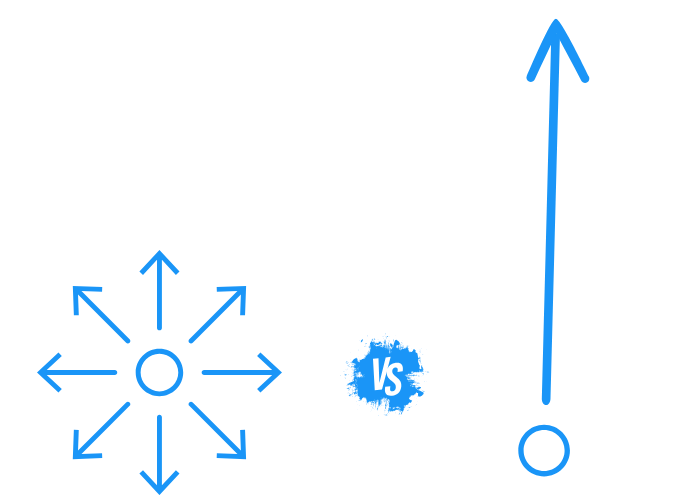Goal-setting is one of the most effective tools to realize your dreams. Learning how to set goals and achieve them fuels motivation, increases self-confidence, and leads to a more fulfilling life.
But setting GREAT goals isn’t easy.
New Year’s Resolution statistics show that 64% of people quit after one month. In fact, only 9% succeed. And I, too, struggled to set effective goals in the past.
I often see these 4 key problems:
- You’re unsure how to set goals and procrastinate.
- You set unrealistic goals and become frustrated.
- You set vague goals and lose motivation.
- You lack a clear plan to achieve your goals.
So how to set the ultimate goal that drives continuous success?
In this comprehensive guide to goal-setting, I’ll share a simple 7-step approach that I use to set goals and achieve them, including personal examples.
So, let’s dive in!
- What is a goal?
- What is goal-setting?
- Characteristics of a goal
- Importance of goal-setting
- Benefits of having goals in life
- 7 Easy steps to set effective goals
- 7 Tips for setting personal goals
- 5 Tips for setting goals at work
- 11 Tips to achieve your goals
What is a goal?
A goal is a desired outcome that you want to achieve. Setting goals provides direction and focuses your efforts. Goals also contain deadlines, moving you into action.

Most people split their objectives into two categories: short-term vs long-term goals. Short-term goals are achievable within 12 months, whereas long-term goals take longer than a year to accomplish.
Do you want to set good goals?
Then you should set SMART goals. This acronym stands for Specific, Measurable, Achievable, Relevant, and Timely. But more about this later.
A few good goal examples include:
- Lose 10 pounds in 3 months.
- Play the guitar daily for an hour for 6 months.
- Unlock a promotion or pay raise at work this year.
- Start your own business within 5 years.
- Travel to Europe in the next 2 years.
To better understand what goals are, let’s clarify…
What are not goals?
Here are popular examples of what goals are not:
- Wishes are things you would like to happen.
- Desires are outcomes you really want to happen.
- Dreams are your most aspirational and ambitious desires.
- New Year’s resolutions are the commitment you make to yourself to change something in your life – which you can turn into goals.
They’re not goals because they almost always lack a time-sensitive element and/or you’re not actively working towards them.
The following topics serve the goal-setting process – but are not goals themselves:
- Your life’s purpose: The reason why you do what you do. It’s the driving force that helps you stay motivated when things get tough.
- Personal vision statement: This statement describes your ideal future and who you would like to become.
- Personal mission statement: Your mission outlines the change you seek to make or the problem you would like to solve or help solving.
Your purpose, mission, and vision are not goals. Yet, they can serve the goal-setting process. Which raises the question:
What is goal-setting exactly?
Goal-setting is the process of identifying specific objectives or desired outcomes that you want to accomplish within a defined timeframe.

This process involves:
- Clarifying exactly what you want.
- Creating a crystal-clear plan to achieve it.
- And taking action to realize your goals.
Setting and achieving goals provides a structured approach to personal and professional development, success, and happiness.
And mastering this skill is both fun and rewarding.
So let’s first demystify the characteristics of goals.
Goal characteristics

Every goal contains the following aspects:
- A function
- A timeframe
- An objective
Let’s dissect these elements.
Function-based goals
As the name suggests, function-based goals represent a function. Here’s a list of the most popular types:
- Personal goals are important to you as an individual. Think about creative expressions and exploring your passions.
- Professional goals involve everything related to how you make money, including business and career goals.
- Health goals relate to your physical and mental health, such as exercising, reducing stress, and getting enough sleep.
- Financial goals involve your personal finances like saving for emergencies, investments, and planning purchases.
- Relationship goals consist of all interactions with others, including your partner, family, friends, dating life, and meeting new people.
- Spiritual goals reflect your connection to something greater than yourself, such as meditation, religion, and pursuing your purpose.
- Educational goals include any new skill or high-income skill you want to learn, and knowledge you want to gain.
- Fun goals include all adventurous stuff like traveling, going for multi-day hikes, and exploring a new journey.
- Community goals relate to your contributions to your community, such as volunteering your time and donating money to charity.
Function-based goals provide a structured way to categorize your aims into buckets. And for each of these items, you can set several…
Time-based goals
The most popular time-based goals include:
- Short-term goals: achievable within 12 months. These smaller goals drive consistent action. This type includes quarterly goals, monthly goals, weekly goals, and even daily goals.
- Long-term goals: take 1+ year to achieve. They often reflect your greatest dreams and aspirations. Think about life goals, 10-year goals, 5-year goals, 3-year goals, and yearly goals.
That said, there are no unanimously agreed definitions. And the time frames vary wildly per person and organization.
Some people use a 3-split goal-setting structure:
- Short-term goals: <1 year
- Mid-term goals: 1-3 or 1-5 years
- Long-term goals: 3+ or 5+ years
And you can even use four buckets:
- Micro goals: <1 week.
- Short-term goals: 1 week to 1 year.
- Mid-term goals: 1-3 or 1-5 years.
- Long-term goals: 3+ or 5+ years.
While I use micro, short-term, and long-term goals, the exact definitions aren’t that important.
What matters is using a way to organize your goals that works for you. However, most effective goals contain long-term and short-term aspects. But more about that in the step-by-step process.
Let’s discuss the final component.
Objective-based goals
Once you know what goals to set (function-based) and when you want to achieve them (time-based), all that’s left is what you want to accomplish.
You can split the types of objectives into three categories:
- Outcome goals are the most popular type, and success is often binary. Win the race (or lose). Finish a marathon (or fail). Buy your dream house (or not buy it). Earn $100K this year (or not).
- Process goals are specific actions or behaviors that you need to take, often to achieve an outcome goal. For example, if your main goal is to lose weight, exercising 4 times per week or eating 2,000 calories per day could be excellent process goals.
- Performance goals are based on personal standards or performance targets at work. Examples include making 3 sales today or achieving a certain score on your test.
I only set outcome goals in the past.
As a result, my confidence took a hit every time I failed to achieve my goal and I struggled to stay motivated.
So here’s the general rule I use: the shorter your timeframe, the more you should focus on process goals instead of the other two.
Process goals are easy to measure and within your control. They are perfect for daily progress tracking and provide frequent (mental) rewards.
Hoorah, I just wrote another 200 words about goals.
However, you also want outcome and performance goals because they reflect your true desires and aspirations. Think about running a marathon in under 3 hours, traveling to 50+ countries, or buying your dream house.
Goal examples of the characteristics
We discussed the three ingredients of any particular goal:
- Function
- Time
- Objective
We’ll now take a look at this in action by dissecting a few goal examples. Doing so will help you in the 7-step goal-setting process.
Example goal #1: Eat 1,800 calories per day to lose weight for 2 months.
- Function: Health goal
- Time: Short-term goal
- Objective: Process-oriented
Example goal #2: Run a marathon under 3 hours within 5 years.
- Function: Fitness goal (or health goal)
- Time: Long-term goal
- Objective: Performance-oriented
Example goal #3: Start your own business within 3 years.
- Function: Business goal (or professional goal)
- Time: Mid- or long-term goal
- Objective: Outcome-oriented
Why is goal-setting important?
Setting goals is important to help you achieve your desired outcomes.
First, it provides a target to aim at.
Without an objective, you can work hard but still get nowhere. I’ve made this mistake too. Although I was spinning my wheels, I wasn’t getting any closer to my dreams.

Secondly, goal-setting provides clarity and self-awareness.
You see, many people first want to know exactly what they want before setting goals. They wait for an epiphany moment – and they wait forever.
Instead, imperfect action leads to insights and self-awareness much faster, allowing you to set better and more effective goals.
Here’s what the sequence looks like:
- Goals drive action and momentum.
- Action generates clarity and awareness.
- Clarity enables you to set better and more meaningful goals.
Regardless of whether you know exactly what you want or struggle to clarify your ideal future, you’re better off setting imperfect goals to generate momentum than having no direction at all.
Let’s further understand the importance of goals by reviewing the…
Benefits of having goals in life
Goal-setting is important because there are many, and I mean many, benefits of having goals. Here are only a few key reasons:
- A sense of purpose: Goals clarify where you want to go and what you want to achieve, providing direction and meaning to your life.
- A sense of control: Having something to work towards puts you in the driver’s seat of your life, which feels empowering.
- Autonomy: Goal-setting means deciding what you want to achieve and who you want to become, contributing to a sense of freedom.
- Focus: Goals focus your time and energy on what’s most important to you, empowering personal excellence.
- Motivation: Setting goals inspires you into action and fuels constant progress. It also helps you to stay on track.
- Self-esteem: Achieving your goals feels amazing and provides a sense of competence, making you feel proud and confident.
- Personal growth: Goals often require you to stretch beyond your comfort zone, learn new skills, and overcome challenges.
- Personal fulfillment: Pursuing your goals makes you the creator of your life rather than a victim of circumstances.
- Long-term success: Setting clear targets and a plan to achieve them increases your likelihood of taking consistent action.
Goals helped me to identify meaningful objectives. As a result, I woke up much earlier and felt excited to get out of bed in the morning.
The long-term benefits? I’m now a freelance SEO specialist with the freedom and time flexibility that I always dreamt of.
Goal-setting turns your dreams into an inspiring action plan.
7 Easy steps to set effective goals
Goal-setting is difficult because almost everyone struggles to strike a balance between ambitious and attainable goals. And setting clear and relevant goals adds another layer of complexity.
I’ve struggled with it too.
Yet, learning how to set and achieve goals will transform your life.
Or at least, it did for me.
Now, I’ve experimented a lot. And I’ve found the following step-by-step approach very effective for continuous goal success:

- List your aspirations
- Specify your targets
- Clarify your goals
- Quantify your goals
- Establish deadlines
- Break down your goals
- Act on your goals
We’ll apply the best goal-setting frameworks in these steps, like SMART goals.
Let’s take a look at these steps.
Step 1: List your aspirations

The first step is to explore your inner world and list all of your desires and aspirations. And the list of function-based goals is a helpful framework to use.
Do you remember them?
- Personal development goals
- Professional development goals
- Health and wellness goals
- Relationship goals
- Financial goals
- Spiritual goals
- Creative goals
- Adventurous goals
- Community goals
Now go through this list and write down all life goals that come to mind. What do you want to achieve, experience, and become in your personal and professional life?
Make sure you establish goals in most – if not all – categories.
After all, success in one area is no guarantee for a successful life.
Many people focus on career goals and neglect the rest. And while they may achieve “massive success”, they still feel very unhappy.
While you can prioritize certain categories, it’s important to cover all important areas to truly create your best life. At the very least pay attention to your health, wealth, career, and relationships.
Exercise: Grab a pen and paper and start brainstorming your life goals.
Step 2: Specify your targets

The second step is all about clarifying your aspirations. This process turns your desires into concrete objectives.
The idea is simple: Be as specific as possible.
Avoid vague statements like I want to be successful or I want to feel happy. What does that mean exactly?
For example, I want to earn a living from my website. And I wanted to pursue a career that would teach me relevant skills to achieve this goal.
So here are my specific goals:
- Earn a full-time income from my blog.
- Find a career that builds the skills to achieve #1.
Both points can be more specific.
A blog about what?
What kind of skills would I need?
Ultimately, I got to this list of aspirations a few years ago:
- Career goal: Become an SEO consultant at a company.
- Business goal: Earn a living from my personal development blog.
- Health goal: Hold a 1-arm handstand.
- Finance goal: Buy a house in the mountains.
- Relationship goal: Go on frequent dates.
- Adventure: Travel around the world.
Now it’s your turn.
Exercise: Go through each of the aspirations and desires you identified in step 1 and make them as specific as possible.
Step 3: Clarify WHY you want it

This third step may seem redundant.
After all, it’s pretty clear why you want what you want.
Right?
Well, you may be surprised how many people create goals for the sake of it. As a result, they lack commitment and lose motivation.
That same thing happened to me, too.
Earning a million dollars was one of my primary desires. And as a result, I chased quick money and bought into get-rich-quick schemes.
I jumped from one thing to the next and often became frustrated with the process. At some point, I started wondering if there wasn’t a better way.
Why do I even want to earn a million dollars?
Long story short, what I wanted was to work for myself, on my own schedule, from anywhere in the world. And to do meaningful and interesting work that contributes to a better world.
So I stopped playing poker, which was my latest strategy to get rich, and instead set the goal to earn a living writing.
This goal is more meaningful to me, and thus, more inspiring.
Clarifying WHY your goals are meaningful to you forces you to think and consider your goals. And it can save lots of frustration down the road.
The more authentic your aspirations, the more likely you are to stay motivated and focused to achieve your goals.
Exercise: Write down each goal and why it’s important to you. Again, be as specific as possible. Does your answer feel right? Then move on. If not, explore how you can make your target more authentic to you.
Step 4: Quantify your goals

So far, you specified what you want to achieve and why.
Now, you want to turn your objectives into measurable goals.
Quantifying your goals allows you to set milestones and track progress more easily. It provides frequent feedback, helping you stay on track.
Some goals are easy to quantify, like losing 10 pounds.
But what about more complex goals?
Let’s take a look at my goal examples:
- Earning a living from my blog: The first step is identifying how much it costs to live your ideal life. For me, that means never worrying about money and taking my parents on several holidays. About $100K per year would allow me to live that lifestyle.
- Becoming an SEO consultant: This goal isn’t easily quantifiable and in this case, I identified milestones. For example, mastering the fundamentals is one milestone. Another is to become the lead consultant for a small client.
- Buying a house in the mountains: What does a house in the mountains cost? Make that number your savings goal.
Quantify your goals in any way you can. And if there’s no easy way then identify smaller milestones to measure progress.
Here’s what I ended up with:
- Career goal: Become an SEO consultant at my company, consistently clarifying essential milestones.
- Business goal: Earn $100K per year from blogging.
- Health goal: Hold a 10-second 1-arm handstand.
- Finance goal: Buy a $250K house in the mountains.
- Relationship goal: Go on a bi-weekly date.
- Adventure: Travel to 30+ countries.
Now it’s your turn.
Exercise: Quantify your targets to create measurable goals.
Step 5: Set challenging yet achievable deadlines

Adding an exact date by which you want to achieve your objectives is the final step to turning your targets into concrete goals. The shorter the time frame, the more realistic your goals should be.
When do you want to achieve your targets?
Here’s my personal example:
- Career goal: Become an SEO consultant within 2 years.
- Business goal: Earn $100K per year from blogging in 10 years.
- Health goal: Hold a 10-second 1-arm handstand within 5 years.
- Finance goal: Buy a $250K house in the mountains in 20 years.
- Relationship goal: Enjoy a bi-weekly date – forever.
- Adventure: Travel to 30+ countries within 3 years.
You may notice that most of these goals support each other quite well, except for my career and adventure goals.
So what do you do with conflicting goals?
Prioritize your goals if needed
We all have 24 hours in a day. And although you can achieve a lot more than you can imagine within those hours, there’s a limit.
Let’s zoom in on my conflicting goals:
- Career: Become an SEO consultant within 2 years.
- Adventure: Travel to 30+ countries within 3 years.
These goals conflict because I knew that I couldn’t achieve them at the same time. And without self-belief, you’ll likely fail to achieve your goal.
Instead, use this 4-step question framework to resolve the conflict:
- Can you achieve your goals simultaneously?
- Can you move the deadline for one or both goals?
- Can you adjust the goals to make them both achievable?
- And if nothing else works, which outcome do you want more?
Here’s how it applies to my personal goals:
- No, I need full focus on my career goal.
- Yes, I could change my travel goal deadline.
- Yes, I could travel to 5 countries instead of 30.
- There’s no need to consider this final radical option.
I knew that achieving my career goal would allow me to become a freelance SEO specialist. And that would enable my adventure goal.
So, I changed my travel goal to 30+ countries within 10 years.
Some goals are optional while others will mean the world to you. Make the latter your priority and identify how you can blend in the rest.
Exercise: Set challenging yet achievable deadlines for each of your goals – and resolve any conflicting goal deadlines.
Step 6: Break down your goals

When you set deadlines and decide your main goal or objectives, you’ve already identified the big-picture timeline.
It’s time to zoom in and create a plan.
Let’s look at my blogging business goal of earning $100K per year within 10 years. I enjoy writing and strive to turn this passion into a full-time income.
Now, this long-term goal is ambitious and feels daunting to me. I sucked at writing in school. And English isn’t my native language.
Yet, I enjoy writing in English.
So, how can you achieve such aspirations?
You must break your goals into smaller chunks.
And while you break up your goals, keep your priorities in mind.
Example of breaking up a personal goal
Keep in mind that I decided to slow down my blogging goal and delay my travel goal to prioritize my career objective. However, I still broke up my blogging goal, and here’s how:
- 10-Year goal: Earn $100K per year from blogging.
- 10-Year goal: Reach 1+ million people every year.
- 5-Year goal: Earn $2,000 per month from blogging.
- 5-Year goal: Reach 100K+ people every year.
- 5-Year goal: Write 3,000+ hours to learn the craft.
- 2-Year goal: Write 1,000+ hours to learn the craft.
- 2-Year goal: Earn my first $1,000 from blogging.
- 1-Year goal: Make my first dollar from blogging.
- 1-Year goal: Reach 25,000 people with my website.
- 3-Month goal: Upload at least 3 blog posts.
- 1-Month goal: Publish my website.
- 1-Month goal: Complete a blogging fundamentals course.
- This week’s goal: Complete chapter 1+2 of the blogging course.
- Tomorrow’s goal: Brainstorm and decide on a domain name.
Do you notice how I first split up my long-term aspirational goals simply by using smaller numbers?
Also notice how the more immediate deadlines focus on process goals (completing chapter 1+2) rather than outcome (making the first dollar) or performance (reaching 100K+ people per year) goals.
That’s what I recommend you do too.
Exercise: Set short-term objectives for all your medium to long-term goals. Then, break them up further into manageable chunks. And set task-oriented goals for targets with an immediate deadline.
Step 7: Act on your goals

Once you break your goals into smaller, more manageable steps, it’s time to take action on these immediate targets.
After all, making progress is what effective goal-setting is all about.
If you break down your goals far enough, you know exactly what to do today, tomorrow, and the rest of this week.
If not, go back to step 6 to clarify this week’s targets. Then identify today’s task that will help you achieve your weekly goals.
Here are a few more tips to stay consistent:
- Start small: I first aimed to write for 15 minutes per day to develop the habit. Only later did that become 2+ hours. Taking small and manageable steps helps to avoid overwhelm and burnout.
- Have a little buffer: I used to set goals for every day of the week. Now, I leave the weekend empty as a buffer for tasks taking longer than estimated or for unexpected tasks and life events.
- Build habits: Identify which actions must become consistent to achieve your goals. Prioritize those habits and create routines. For example, I designed my morning routine around my writing habit.
- Track progress. Keep track of your progress so that you can stay motivated and see how far you’ve come. For example, I tracked how many words I wrote every single day.
- Celebrate successes. Have rewards in place to celebrate tiny successes. For example, I make a cup of coffee after writing for 45 minutes. And after several hours, I would reward myself with a game of chess or an episode of my favorite series at night.
Consistent action is key to success.
Exercise: Take one tiny step TODAY to get closer to your goals.
Finally, you must frequently…
Bonus step: Renew your goals

You rarely complete goals in a straight line.
The more action you take, the faster you learn and grow. And frequently reviewing and adjusting your goals helps you avoid misalignment.
Here’s the process I use to stay on track:
- Every year, I spend an entire afternoon to:
- Reflect on all my goals, dreams, and aspirations. I use an entire afternoon to reconsider what’s most important to me.
- Set goals for next year, quarter, month, week, and day.
- Every quarter, I spend 1 hour to:
- Reflect on the last quarter and my yearly goals.
- Set goals for the next quarter and break them into monthly ones.
- Every month, I spend 30 minutes to:
- Reflect on the last month and my quarterly and yearly goals.
- Set goals for the next month, including a high-over picture of what I want to achieve each week.
- Every week, I spend 15-30 minutes to:
- Reflect on last week’s goals and my monthly goals.
- Set goals and plan the upcoming week, including an overview of my schedule for each day of the week.
- Every day, I spend 5 minutes to:
- Reflect on my day, daily goals, and weekly goals.
- Set or adjust goals and plan the next day. And I’ll consider any additional tasks or other life events that appear.
The benefit of this approach is as follows:
- You crystallize your clear long-term direction periodically;
- You stay on track through frequent goal-setting and reflection;
- You set tiny goals often to fuel consistent action and motivation.
This bonus step is especially important for long-term goal success.
Looking into the future is challenging. By often reviewing and setting goals, you frequently renew focus and motivation.
7 Tips for setting personal goals
So far, you learned the fundamental steps about goal-setting. Now, let’s rapid-fire a few additional tips to set the most effective goals:
- Use SMART principles: We’ve already mentioned this one a few times and it’s ingrained in the step-by-step approach above. And although it’s boring stuff, it’s effective.
- Set challenging goals: While you should set achievable targets, you also want challenging goals to stay motivated. Balancing the two requires experience. So renew your goals often to gain consistent feedback to improve this skill.
- Pursue your passion: Choose goals that fire you up and make you fully committed for the long haul. At the very least know why your goals are important to you.
- Align goals with your values: Goals that align with your truths instill a sense of control, motivation, and focus.
- Know how you spend your time: Prioritize your goals and allocate your time well to match your priorities.
- Drive continuous action: Operational goals should be 100% within your control to maintain motivation. So incorporate mostly process-oriented goals for your daily and weekly objectives.
- Use active and positive goal statements: Instead of saying avoid weight gain, say exercising regularly. Use active verbs and positive statements to increase your likelihood of success.

5 Tips for setting goals at work
The difference between professional and personal goals is that the latter should align with the interests of your team and company. Doing so will accelerate your career or business success.
Here’s how you can align your goals at work:
- Understand the company and team goals: What’s the big-picture objective? What’s everyone else trying to accomplish? And how can you leverage your personality traits and personal strengths to contribute to the business goals?
- Ask the opinions of your manager: Talk to your manager to understand what’s most important to them. Ask for input about what they believe could be your greatest contribution. These two simple steps can greatly accelerate your career advancement.
- Include your team in the process: If you run a company or team, get the input of your team in the goal-setting process. Not only will involving others increase their commitment, but it also motivates them to align their professional goals with the greater objectives.
- Ask for feedback and reiterate: Share your goals with your team and manager and ask for feedback. Extract their insights and ideas to further optimize your goals. In addition, letting others know what you want to accomplish enables them to help you to achieve it.
- Schedule regular check-ins: Plan moments with your manager or team to review the goals. Doing so creates a sense of personal and shared accountability.
Aligning your goals with your company or team shows your engagement. And that’s how you unlock greater career success and inspire teams to move towards a vision.

11 Tips to achieve your goals
When you use the method from this article, you’re already well on your way to achieving your goals.
The combination of long-term and short-term goals provides a clear direction and drives consistent action. And making consistent progress is how you achieve your goals.
Of course, easier said than done.
So here are the best tips to get over the finish line:
- Write your goals down: Use the best goal planners to solidify your commitment. There’s magic in writing your goals on paper.
- Leverage goal-setting software: Use tools to stay focused and productive every day. Learn more about the software I use in my review of Goals on Track.
- Make your goals visible: Use visualization boards, visualization techniques, and often review your goals to keep them top of mind.
- Set small daily goals – every day: Setting and achieving daily goals provides consistent victories that drive massive success.
- Break goals down: If your short-term goals feel daunting or overwhelming, keep breaking them down into manageable steps.
- Focus on behavioral change: Who do you need to become in order to accomplish your goals? Identify the particular behavior you need and set goals to achieve behavioral change.
- Build habits and routines: Goals, habits, and routines support each other. For example, I first set daily process goals to write for 15 minutes to establish my writing habit.
- Identify potential obstacles: Anticipate challenges and develop strategies to overcome them. For example, avoid buying junk food and candies in the supermarket if you want to lose weight. And do your groceries after lunch or dinner, not when you feel hungry.
- Find an accountability buddy: Partner with someone who has (similar) goals and keep each other accountable to stay on track.
- Track progress: Measuring and seeing progress motivates you to keep going. And it enables you to adjust your goals if needed.
- Reward progress – not only results: Reward yourself for taking action. For example, I’ll make a cup of coffee after I write for 45 minutes. And the reward for a long writing session is an episode of my favorite series at night.

What’s next?
Goals provide a clear direction, a sense of purpose, and help you to get and stay motivated. Goal-setting fuels continuous self-improvement, personal fulfillment, and success.
You need goals if you want to become the creator of your destiny, achieve meaningful outcomes, and realize your dreams.
The 7 key steps to set and achieve your goals:
- Identify your aspirations, including a vision for your future self and what you want to achieve and experience in all areas of your life.
- Specify your targets to make them crystal-clear.
- Clarify WHY it’s important to ensure you set relevant goals.
- Quantify your goals by adding numbers or milestones.
- Set deadlines to turn your targets into concrete goals.
- Break your goals into smaller and more manageable steps.
- Act on your goals to gain momentum.
- Bonus: Renew your goals to keep your targets on top of your mind and adjust for any new obstacles or challenges.
Dive deeper with the following resources:
- The best goal-setting planners
- The best goal-setting books to up your game
- Goals on Track review: Is this the best goal-setting software?
- Goal-Setting Mastery: 10X Your Results in 12 Months
Take action: Challenge yourself to set one SMART goal today. If you have a dream, start there. If not, set a 30-day challenge to try something new. Write it down, break the goal into smaller tasks, and take action immediately.
Are you ready to take full control and create your ideal life? Sign up below for actionable strategies to transform yourself and achieve your dreams!


